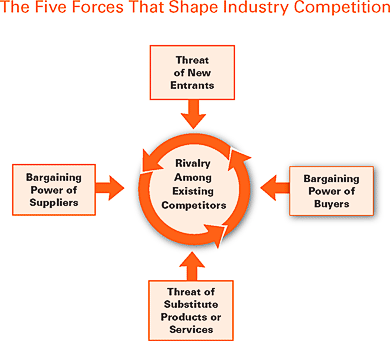 Porter’s 5 forces model illustrates current competition and the potential for new rivals. First published in 1979 and recently revised by Harvard Business Review, the model effectively represented strategic thinking at that time and urged companies to look beyond their current competitors to foresee threats from new entrants. The model also highlights how a business’s supply chain influences its success through its suppliers and customers.
Porter’s 5 forces model illustrates current competition and the potential for new rivals. First published in 1979 and recently revised by Harvard Business Review, the model effectively represented strategic thinking at that time and urged companies to look beyond their current competitors to foresee threats from new entrants. The model also highlights how a business’s supply chain influences its success through its suppliers and customers.
Changes Necessary in the Age of Social Media
The business world in the ’70s was quite different from today, needing different strategies to succeed. The “dog eat dog” attitude of that era has shifted to a collaborative approach to competition, focusing on building long-term relationships that expand the overall market — allowing everyone to get a larger share — instead of greedily trying to grab as much as possible from a smaller market.
Now, that isn’t to say businesses are all holding hands singing Kumbaya, but fierce competition is replaced by cooptition — the notion that businesses must cooperate to survive and competition is based on providing strategic competitive advantage rather than killing the competition.
And, while Porter’s 5 forces model paid lip service to the role of suppliers and buyers in ensuring business success, today’s environment requires an egalitarian notion giving these partners equal standing.
So, let’s take a look at specific changes wrought by social media.
Changing Forces in Social Media
The power of buyers
In the original 5 forces model, buyers only had power in B2B markets where only a few buyers bought vast amounts of a company’s products. In the new 5 forces model, social media gives power to thousands of individual consumers who talk about the brand within their social networks. Businesses must cater to these individuals, respond to their concerns, reward their compliments.
Ignoring the power of your consumers is no longer an option
Power of the Media
Porter’s 5 forces model never recognized the power of the media to impact consumer attitudes, which in turn impact their buying decisions. Frankly, I’m surprised no one ever added this very real force to the model.
In the days of social media, you have not only legitimate news outlets (a number shrinking every minute), but a vast number of bloggers who cover your market. These folks post reviews of your product, share information about you (both positive and negative), and provide instructions for users to get the most from your products.
Joining the group of bloggers are advocates for your brand across social networks like Facebook, Twitter, and G+. Sometimes called brand evangelists or collectively as your tribe, the value and importance of individual Word of Mouth and blog media can’t be overstated.
Ignoring the power of social media is no longer an option
Power of New Entrants
The threat of new entrants into your market is tremendous and the low cost of advertising on the internet gives them easy access to your market — especially if you’re not all you can be online.
Not only should you proactively scan for the prospect of new entrants, as in the original 5 forces model, you need to reach out to them and invite them into your tribe.
Remember the old saying: “Keep your friends close and your enemies closer”. But, seriously, you need to understand these new entrants and get them to start helping you rather than letting them dethrone you with new ideas and strategies that surpass your current advantage. You also don’t need these bright, innovative competitors cooperating with your existing competitors to force you out.
Bring possible new entrants into your tribe as soon as they’re identified
I hope you get the idea of how Porter’s 5 forces model is modified to improve your strategies in the age of social media. Certainly, social media affects Porter’s 5 forces model in other ways. If you can think of some, please add them here.